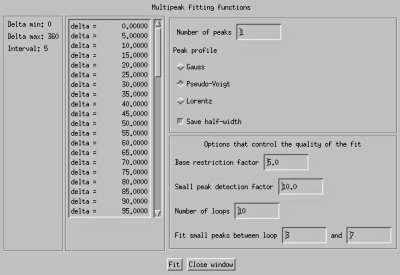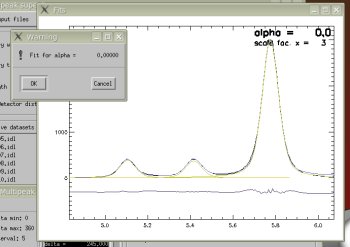|
Texture
In works Memo |
Multifit /
Manual Fit Of Active DatasetFitting peaks in a sub-pattern: starting upIn order to fit peaks within a sub-pattern, select the image you want to work on in the  Manual fit dialog You can choose
The second panels includes things to trick multifit for a better results. In theory, you should not have to play with those. Parameters include things such as
Fitting peaks in a sub-pattern: fitAt the beginning, you'll be asked to
Multifit will then optimized the parameters and come up with a suggestion.
 Multifit asking for a confirmation You will be asked to confirm,
If no problem occurs, Multifit will propagate the fit to all others azimuth angles. If something wrong occurs (peaks changing width too fast, peaks with negative intensity...), multifit will stop and offer three choices
Saving resultsAt then end, Multfit will plot 2theta, intensities, and half-width values it found vs. azimuth angles. Saving the data is possible. I recommend a
where D0607_005 is the datafile and 1, 2, 3 are sub-patterns numbers. You'll be asked for a title, I usually give the indices of the peaks so I can remember. This file is in pure text format and looks like this
# My title
# delta, then 2 theta, d, intensity, and
# half-width (and maybe relative weight gauss/lorentz) for each peak
0.00 7.4563 1.4666 169.37 0.14
5.00 7.4564 1.4666 179.30 0.14
10.00 7.4532 1.4672 265.96 0.11
15.00 7.4534 1.4672 158.27 0.14
20.00 7.4545 1.4670 52.47 0.14
25.00 7.4525 1.4674 131.18 0.14
30.00 7.4515 1.4675 110.29 0.14
35.00 7.4494 1.4680 98.61 0.15
40.00 7.4470 1.4684 81.55 0.15
45.00 7.4435 1.4691 79.46 0.14
50.00 7.4468 1.4685 80.43 0.14
55.00 7.4429 1.4692 67.29 0.14
60.00 7.4416 1.4695 74.24 0.15
65.00 7.4420 1.4694 98.11 0.12
70.00 7.4436 1.4691 83.35 0.13
75.00 7.4404 1.4697 110.83 0.14
80.00 7.4388 1.4700 111.72 0.13
...
|